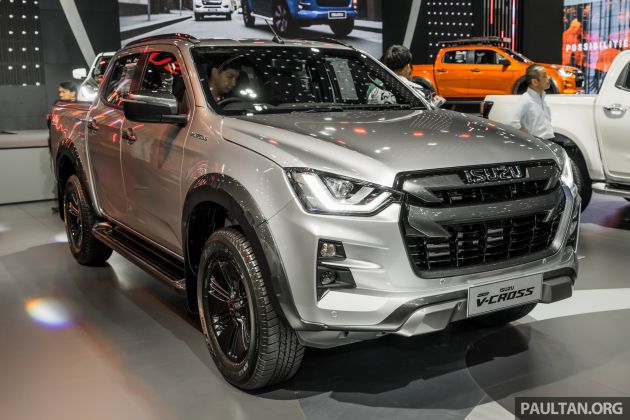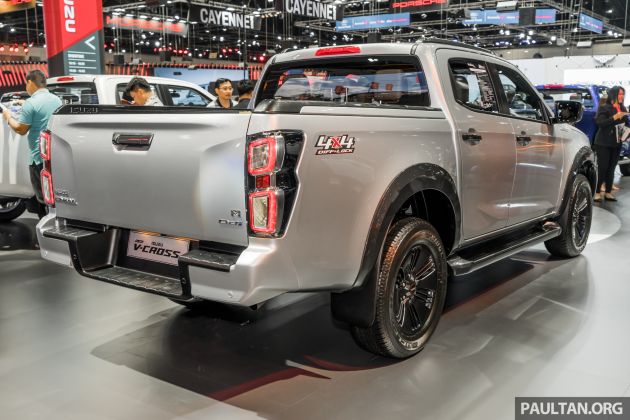The new Isuzu D-Max was unveiled in Thailand in October, and its appearance at the recent Thailand International Motor Expo gave us a chance to get up close and personal with the third-generation pick-up truck. As you can see in these pictures, the vehicle has been given an almost complete overhaul, not least of which being the revamped exterior design that banishes the outgoing model‘s old-school look.
In its place is a modern and rather aggressive look, the front end being dominated by a massive Audi-style grille that stretches the full height of the front end. It continues to feature two fang-like chrome bars along the top edge, flanked by slimmer headlights that are available with bi-LED technology, equipped with U-shaped LED daytime running lights; the indicators and fog lights are stacked below them.
It should be noted that this look is reserved only for the range-topping models, such as the V-Cross 3.0 Ddi M you see here. Other variants, like the black Cab4 1.9 Ddi Z in the gallery below, get a smaller grille and a more conventional bumper.
The more wedge-shaped side profile is said to be more aerodynamic, having been tested at the wind tunnels of Japan Railways’ (JR) Railway Technical Research Institute. Further improving efficiency is a large underbody shield that reduces turbulence underneath the truck. Aesthetically, the new D-Max gets smoother wheel arch bulges and a strong shoulder line that visually links the cab to the bed.
Moving to the rear, you’ll find twin-barrel tail lights with clear lenses and LED edge lighting for a more distinctive design, while the rear bumper of higher-end models is now integrated into the bed for a sleeker, more streamlined look. The top 18-inch alloy wheel option is new too, and it also looks more aerodynamically efficient compared to past designs.
The changes are even more apparent inside. Gone is the rather unimaginative dashboard of the outgoing model – where the only distinctive cue was the circular climate controls – in favour of a modern angular design more in keeping with buyers’ tastes. Perceived quality has been improved with the use of embossed and textured materials, including a stitched soft-touch upper dashboard on some variants.
Front and centre is a hexagonal centre stack, within which buyers will now be able to specify a nine-inch infotainment touchscreen, complete with Apple CarPlay and Android Auto connectivity. The speaker count has also risen to a maximum of eight, and the centre console is now taller and wider to envelop the driver and front passenger. Of course, a simpler and sturdier cabin remains available for commercial versions.
The electrical architecture has been upgraded to prepare for future connected, autonomous, shared, and electrified (CASE) technologies, although the D-Max still isn’t even available with autonomous emergency braking. It is, however, offered with more seat belt reminders and blind spot monitoring with rear cross traffic alert for the first time, and as before you still get up to six airbags and stability control.
Better yet, the upgraded electronics allow for all sorts of new features, including walk-away automatic locking, remote engine start, welcome and follow-me-home lighting, voice control and dual-zone automatic climate control (with rear vents). You can also get the truck with auto lights and wipers, and the latter even get integrated washers for uninterrupted visibility – just like Mercedes-Benz’s Magic Vision Control!
Other new measures improve the D-Max’s comfort and ergonomics, which weren’t exactly the old car’s strong suits. These include tilt and telescopic steering adjustment, as well as front seats with standard whiplash protection, low-rebound MDI polyurethane cushions to reduce fatigue on long journeys, and optional eight-way power adjustment for the driver. The double cab’s rear seats have also been redesigned to improve ride comfort, while the B-pillars have been moved forward to ease entry and egress for those at the back.
Developed under the concept Efficient and Robust, the new D-Max is said to deliver reduced fuel consumption and improved safety, whilst still being versatile enough to suit different needs and conditions. The most popular high-riding double cab model measures 5,265 mm long, 1,870 mm wide and 1,790 mm tall, making it 30 mm shorter, 10 mm wider and five millimetres lower; its 3,125 mm wheelbase is 30 mm longer.
It also rides on a new Isuzu Dynamic Drive Platform, and while it still utilises body-on-frame construction, the ladder frame itself has seen a great number of improvements. The company has expanded the cross section, optimised the locations of the crossmembers and increased impact absorption, making the frame not only lighter, but stiffer and safer than before. The standard body mount has also been substituted for a shear mount to improve driving stability and reduce noise and vibration levels.
Meanwhile, the body sees a greater proportion of high-tensile steels being used, with application of those rated higher than 390 MPa – some as much as 980 MPa – increased from 30% to 46%. This has increased rigidity by 20% and reinforced the roof area, while keeping weight low. The improved packaging has also enabled Isuzu to lengthen the bed on all cab variants.
The suspension has also been comprehensively revamped. The front double wishbones get higher upper link mounts to improve stability, while the rear leaf springs have been manufactured using a process called warm stress shot peening to make it more durable, yet with better flexibility for a more comfortable ride. A wider rear track and a reduced mounting angle for the dampers also aid stability.
Elsewhere, the steering unit has been retuned to require less effort to turn the wheel, and the ratio has also been adjusted to presumably make the D-Max feel a trite more agile. The steering angle has also been increased to improve handling, and the turning radius has been reduced as a result. The brake discs are also larger, now measuring 320 mm and clamped by two-piston callipers at the front. The front wheel hub bearings are now integrated into a unit bearing, making them maintenance free.
Power comes from the same 1.9 litre and 3.0 litre four-cylinder turbodiesels, the former having just been introduced in Malaysia. The smaller, newer RZ4E-TC engine remains unchanged and makes an identical 150 PS at 3,600 rpm and 350 Nm of torque from 1,800 to 2,600 rpm, but it gets optimised gear ratios and control systems for improved acceleration.
It’s the larger 3.0 litre mill – rechristened the 4JJ3-TCX – that has received the lion’s share of updates, incorporating some of the learnings from the 1.9 litre. These include a reshaped combustion chamber, higher-pressure injectors, a diamond-like carbon coating on the piston pins, an electronic variable geometry turbocharger and a double-scissor timing gear, amongst others. All-in-all, it now makes 190 PS and 450 Nm – increases of 13 PS and 70 Nm over the old 4JJ1-TCX.
To improve weight distribution, the engine has been moved slightly behind the front axle, resulting in what Isuzu rather cutely calls a “semi-midship” layout. The automatic and manual transmissions now feature six speeds across both engines, with the manual getting a pull-ring gearlever to engage reverse. The 1.9 litre’s auto also gets a smaller torque converter and a wide-angle damper integrated into the lockup clutch to improve fuel efficiency and response.
Four-wheel drive models get a number of additional improvements, including a one-piece aluminium propshaft to deliver a significant weight saving, as well as an electromagnetic rear differential lock. This makes it quicker to switch between two- and four-wheel drive and between high and low ratios. Water wading depth has also been increased, now sitting at a massive 800 mm.
The new Isuzu D-Max is offered in Thailand in a wide range of commercial and consumer variants split across single cab, extended cab and double cab body styles, some of which you can see in the gallery below. Prices range from 510,000 baht (RM70,200) to 1,164,000 baht (RM160,300).
Source: Read Full Article















